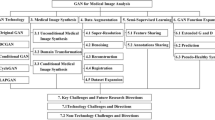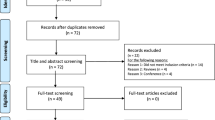Abstract
The rate at which different diseases are develo** and emerging has made us aware of the need to develop new techniques to identify the problem in the medical field; it necessitates the creation of quick and precise diagnostic tools despite the absence of available samples or datasets. One such application could be using thermal images to detect various health problems even before using any invasive tools for the diagnosis of any medical condition. In medical thermal imaging, the limited availability of data can make it difficult to train accurate deep learning models. This issue can be solved and the accuracy of deep learning models in this field improved with the use of data augmentation techniques and semi-supervised learning or active learning.
Generative adversarial network (GAN) have been one of the most inventive advancements in machine learning in recent years. Using the GAN approach, a large artificial dataset of images can be generated from a less number of images, which could be very helpful for the diagnosis of any disease. These images are artificially created; there are no original patient records or privacy issues. The easy sharing of data among hospitals and diagnostic institutions enables access to a vast array of unique dataset combinations, facilitating the prompt identification of solutions to various problems.
We can generate random images from the given dataset in a significant number of instances using a limited collection of images without any class by using the technique of unconditional GAN. In this chapter, we will learn about the unconditional GAN or self-supervised GAN (ssGAN)-based image generation technique. We will briefly study the advantages and applications of using such techniques, which could be very helpful in data generation and analysis.
Access this chapter
Tax calculation will be finalised at checkout
Purchases are for personal use only
Similar content being viewed by others
References
Goodfellow, I., et al. (2020). Generative adversarial networks. Communications of the ACM, 63(11), 139–144. https://doi.org/10.1145/3422622
Tian, L., Wang, Z., Liu, W., Cheng, Y., Alsaadi, F. E., & Liu, X. (2021). A new GAN-based approach to data augmentation and image segmentation for crack detection in thermal imaging tests. Cognitive Computation, 13(5), 1263–1273. https://doi.org/10.1007/s12559-021-09922-w
Chen, H. (2021). Challenges and corresponding solutions of Generative Adversarial Networks (GANs): A survey study. Journal of Physics: Conference Series, 1827(1). https://doi.org/10.1088/1742-6596/1827/1/012066
Treneska, S., Zdravevski, E., Pires, I. M., Lameski, P., & Gievska, S. (2022). GAN-based image colorization for self-supervised visual feature learning. Sensors, 22(4). https://doi.org/10.3390/s22041599
Taherkhani, F., Dabouei, A., Soleymani, S., Dawson, J., & Nasrabadi, N. M. (2021). Self-supervised Wasserstein pseudo-labeling for semi-supervised image classification. In Proceedings of the IEEE/CVF conference on computer vision and pattern recognition (pp. 12267–12277).
Araslanov, N., & Roth, S. (2021). Self-supervised augmentation consistency for adapting semantic segmentation. In Proceedings of the IEEE/CVF conference on computer vision and pattern recognition (pp. 15384–15394). Available: https://github.com/visinf/da-sac.
Song, J., Li, P., Fang, Q., **a, H., & Guo, R. (2022). Data augmentation by an additional self-supervised CycleGAN-based for shadowed pavement detection. Sustain., 14(21). https://doi.org/10.3390/su142114304
Elaraby, N., Barakat, S., & Rezk, A. (2022). A conditional GAN-based approach for enhancing transfer learning performance in few-shot HCR tasks. Scientific Reports, 12(1). https://doi.org/10.1038/s41598-022-20654-1
Gauthier, J. (2014). Conditional generative adversarial nets for convolutional face generation. Class project for Stanford CS231N: Convolutional neural networks for visual recognition. Winter Semester, 2014(5), 2.
Ludwig, N., Formenti, D., Gargano, M., & Alberti, G. (2014). Skin temperature evaluation by infrared thermography: Comparison of image analysis methods. Infrared Physics & Technology, 62, 1–6. https://doi.org/10.1016/j.infrared.2013.09.011
Snekhalatha, U., Rajalakshmi, T., & Gobikrishnan, M. (2018). Automated segmentation of knee thermal imaging and X-ray in evaluation of rheumatoid arthritis. International Journal of Engineering & Technology, 7, 326–330.
Gizińska, M., Rutkowski, R., Szymczak-Bartz, L., Romanowski, W., & Straburzyńska-Lupa, A. (2021). Thermal imaging for detecting temperature changes within the rheumatoid foot. Journal of Thermal Analysis and Calorimetry, 145(1), 77–85. https://doi.org/10.1007/s10973-020-09665-0
Fernández-Cuevas, I., et al. (2015). Classification of factors influencing the use of infrared thermography in humans: A review. Infrared Physics and Technology, 71, 28–55. https://doi.org/10.1016/j.infrared.2015.02.007
Mishra, P., & Pathak, K. (2019). A research paper on thermal imaging system. [Online]. Available: www.jetir.org.
Zhao, S., Liu, Z., Lin, J., Zhu, J. Y., & Han, S. (2020). Differentiable augmentation for data-efficient GAN training. Advances in Neural Information Processing Systems, 33, 7559–7570.
Zhang, X., Wang, Z., Liu, D., & Ling, Q. (2018). Dada: Deep adversarial data augmentation for extremely low data regime classification. In IEEE International Conference on Acoustics, Speech and Signal Processing (ICASSP) (pp. 2807–2811). IEEE.
Maack, L., Holstein, L., & Schlaefer, A. (2022). GANs for generation of synthetic ultrasound images from small datasets. Current Directions in Biomedical Engineering, 8(1), 17–20. https://doi.org/10.1515/cdbme-2022-0005
Patel, M., Wang, X., & Mao, S. (2020). Data augmentation with conditional GAN for automatic modulation classification. In WiseML 2020 – Proceedings of the 2nd ACM workshop on wireless security and machine learning (pp. 31–36), doi: https://doi.org/10.1145/3395352.3402622.
Mizginov, V. A., Kniaz, V. V., & Fomin, N. A. (2021). A method for synthesizing thermal images using GAN multi-layered approach. The International Archives of the Photogrammetry, Remote Sensing and Spatial Information Sciences, 44, 155–162.
Shin, H. C., Tenenholtz, N. A., Rogers, J. K., Schwarz, C. G., Senjem, M. L., Gunter, J. L., … & Michalski, M. (2018). Medical image synthesis for data augmentation and anonymization using generative adversarial networks. In Simulation and synthesis in medical imaging: Third international workshop, SASHIMI 2018, Held in Conjunction with MICCAI 2018, Granada, Spain (pp. 1–11). Springer International Publishing.
Selfe, J., Hardaker, N., Thewlis, D., & Karki, A. (2006). An accurate and reliable method of thermal data analysis in thermal imaging of the anterior knee for use in cryotherapy research. Archives of Physical Medicine and Rehabilitation, 87(12), 1630–1635. https://doi.org/10.1016/j.apmr.2006.08.346
Cueva, J. H., Castillo, D., Espinós-Morató, H., Durán, D., Díaz, P., & Lakshminarayanan, V. (2022). Detection and classification of knee osteoarthritis. Diagnostics, 12(10). https://doi.org/10.3390/diagnostics12102362
Bardhan, S., Nath, S., Debnath, T., Bhattacharjee, D., & Bhowmik, M. K. (2022). Designing of an inflammatory knee joint thermogram dataset for arthritis classification using deep convolution neural network. Quantitative InfraRed Thermography Journal, 19(3), 145–171. https://doi.org/10.1080/17686733.2020.1855390
Lubkowska, A., & Pluta, W. (2022). Infrared thermography as a non-invasive tool in musculoskeletal disease rehabilitation – The control variables in applicability – A systematic review. Applied Sciences (Switzerland), 12(9). https://doi.org/10.3390/app12094302
**, C., Yang, Y., Xue, Z. J., Liu, K. M., & Liu, J. (2013). Automated analysis method for screening knee osteoarthritis using medical infrared thermography. Journal of Medical and Biological Engineering, 33(5), 471–477. https://doi.org/10.5405/jmbe.1054
Frize, M., Adéa, C., Payeur, P., Gina Di Primio, M. D., Karsh, J., & Ogungbemile, A. (2011). Detection of rheumatoid arthritis using infrared imaging. In Medical imaging 2011: Image processing (Vol. 7962, pp. 205–215). SPIE.
Umapathy, S., Vasu, S., & Gupta, N. (2018). Computer aided diagnosis based hand thermal image analysis: A potential tool for the evaluation of rheumatoid arthritis. Journal of Medical and Biological Engineering, 38(4), 666–677. https://doi.org/10.1007/s40846-017-0338-x
Fokam, D., & Lehmann, C. (2019). Clinical assessment of arthritic knee pain by infrared thermography. Journal of Basic and Clinical Physiology and Pharmacology, 30(3). https://doi.org/10.1515/jbcpp-2017-0218
Snekhalatha, U., Anburajan, M., Sowmiya, V., Venkatraman, B., & Menaka, M. (2015). Automated hand thermal image segmentation and feature extraction in the evaluation of rheumatoid arthritis. Proceedings of the Institution of Mechanical Engineers, Part H: Journal of Engineering in Medicine, 229(4), 319–331. https://doi.org/10.1177/0954411915580809
Snekhalatha, U., Rajalakshmi, T., Gopikrishnan, M., & Gupta, N. (2017). Computer-based automated analysis of X-ray and thermal imaging of knee region in evaluation of rheumatoid arthritis. Proceedings of the Institution of Mechanical Engineers, Part H: Journal of Engineering in Medicine, 231(12), 1178–1187. https://doi.org/10.1177/0954411917737329
Suma, A. B., Snekhalatha, U., & Rajalakshmi, T. (2016). Automated thermal image segmentation of knee rheumatoid arthritis. In 2016 International Conference on Communication and Signal Processing (ICCSP) (pp. 0535–0539). IEEE.
Denoble, A. E., Hall, N., Pieper, C. F., & Kraus, V. B. (2010). Patellar skin surface temperature by thermography reflects knee osteoarthritis severity. Clinical Medicine Insights: Arthritis and Musculoskeletal Disorders, 3, 69–75. https://doi.org/10.4137/CMAMD.S5916
Shorten, C., & Khoshgoftaar, T. M. (2019). A survey on image data augmentation for deep learning. Journal of Big Data, 6(1). https://doi.org/10.1186/s40537-019-0197-0
Acknowledgments
This work is made possible by the core grant (HCP-0026-3.2) of the Medical Mission project, which was sponsored by the Government of India, DSIR, Ministry of Science & Technology, CSIR, India, and CSIR-Central Scientific Instruments Organization, Sector-30, Chandigarh.
Author information
Authors and Affiliations
Corresponding author
Editor information
Editors and Affiliations
Rights and permissions
Copyright information
© 2023 The Author(s), under exclusive license to Springer Nature Switzerland AG
About this chapter
Cite this chapter
Mahapatra, P.K., Kumar, N., Singh, M., Saini, H., Gupta, S. (2023). Generative Adversarial Learning for Medical Thermal Imaging Analysis. In: Solanki, A., Naved, M. (eds) GANs for Data Augmentation in Healthcare. Springer, Cham. https://doi.org/10.1007/978-3-031-43205-7_9
Download citation
DOI: https://doi.org/10.1007/978-3-031-43205-7_9
Published:
Publisher Name: Springer, Cham
Print ISBN: 978-3-031-43204-0
Online ISBN: 978-3-031-43205-7
eBook Packages: MedicineMedicine (R0)




